
Detail of a map of North Carolina. (Courtesy, Colonial Williamsburg Foundation.) The approximate locations of (a) Thomas White in Northampton County and (b) John Sanders in Perquimans County, North Carolina, are denoted.

Desk attributed to Thomas White, Perquimans County, North Carolina, 1756–1766. Walnut with tulip poplar and yellow pine, H. 41 1/2", W. 40 1/2", D. 21." (Private collection; photo, Museum of Early Southern Decorative Arts.)

Dressing table attributed to Thomas White, Perquimans County, North Carolina, 1756–1766. Walnut with red cedar, yellow pine, cypress, and tulip poplar, H. 28 5/16", W. 34", D. 21 5/8". (Private collection; photo, Museum of Early Southern Decorative Arts.)

Desk attributed to Thomas White, Perquimans County, North Carolina, ca. 1765. Walnut with white cedar, yellow pine, walnut, and mahogany, H. 43", W. 39 1/2", D. 21". (Courtesy, Museum of Early Southern Decorative Arts.)

Cupboard attributed to Thomas White, Northampton County, North Carolina, ca. 1766. Walnut with yellow pine and tulip poplar. W. 43 3/4", height and depth not recorded. (Courtesy, Willow Oaks Country Club, Richmond, Virginia; photo, Museum of Early Southern Decorative Arts.)
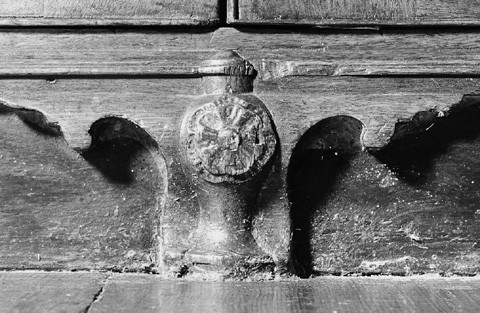
Detail of the center foot on the cupboard illustrated in fig. 5.

Detail of the laminated and carved shell in the cupboard illustrated in fig. 5.

Detail of the interior of the desk illustrated in fig. 4.

Desk with incised inscription “John Goddard 1754,” Newport, Rhode Island. Mahogany; secondary woods not recorded. H. 41 1/2", W. 40 1/2", D. 22 1/2". (Courtesy of Sack Heritage Group) www.sackheritagegroup.com

Detail of the interior of the desk illustrated in fig. 9

Desk attributed to Thomas White, Perquimans County, North Carolina, 1756–1766. Walnut with white cedar, yellow pine, and walnut. H. 43 1/4", W. 43 1/2", D. 21 5/8". (Private collection; photo, Museum of Early Southern Decorative Arts.) The base molding, feet, and brasses are replaced.

Detail of the interior of the desk illustrated in fig. 11.

Detail of the false bottom in the prospect cabinet of the desk illustrated in fig. 4.

Detail of the prospect case removed from the interior of the desk illustrated in fig. 4.
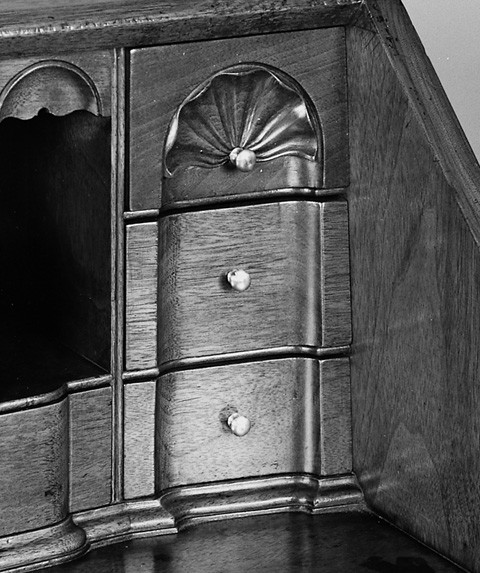
Detail of the flared interior drawers of the desk illustrated in fig. 4.

Detail of the drawers and a quarter-column on the desk illustrated in fig. 11.

Detail of a quarter-column base on the desk illustrated in fig. 4.

Detail of the center foot of the desk illustrated in fig. 4.

Detail of the left foot of the desk illustrated in fig. 4.

Detail of the shaped foot blocking of the desk illustrated in fig. 4.

Detail showing the drawer construction of the desk illustrated in fig. 4.

Detail of a mitered joint on the upper rear drawer frame of the desk illustrated in fig. 4.

Detail of a half-bottom dustboard with kicker in the desk illustrated in fig. 4.

Detail of an upper leg and knee respond on the table illustrated in fig. 3, showing the curved upper profile of the knee at the leg stile.

Dressing table attributed to Thomas White, Perquimans County, North Carolina, 1756–1766. Mahogany with white cedar and yellow pine. H. 28 1/2", W. 32 1/2", D. 21 1/2". (Courtesy, Museum of Fine Arts, Houston; Bayou Bend Collection, museum purchase with funds provided by the Theta Charity Antique Show and Miss Ima Hogg, by exchange.)

Detail of the left front leg of the dressing table illustrated in fig. 25.

Corner chair attributed to Thomas White, Perquimans County, North Carolina, 1756–66. Walnut with yellow pine. H. 30 1/8", W. 18". (Courtesy, Museum of Early Southern Decorative Arts.)

Detail of a leg on the corner chair illustrated in fig. 27.

Side chair attributed to Thomas White, Perquimans County, North Carolina, 1756–1766. Walnut with yellow pine. H. 36 1/8", W. 19". (Courtesy, Museum of Early Southern Decorative Arts.) This chair has a history of descent in the Pettigrew family of Perquimans and Chowan Counties.

Detail of the open splat mortise in the rear rail of the side chair illustrated in fig. 29.

Tall case clock attributed to Thomas White, Northampton County, North Carolina, 1766–1788. Walnut with yellow pine. Dimensions not recorded. (Private collection; photo, Museum of Early Southern Decorative Arts.)

Detail of a quarter-column base on the tall case clock illustrated in fig. 31.

Desk attributed to John Sanders, Perquimans County, North Carolina, 1750–1760. Cherry with white cedar, cypress, and yellow pine. H. 42 1/8", W. 41 1/4", D. 21 3/4". (Private collection; photo, John Bivins.)

Detail of the interior of the desk illustrated in fig. 33.
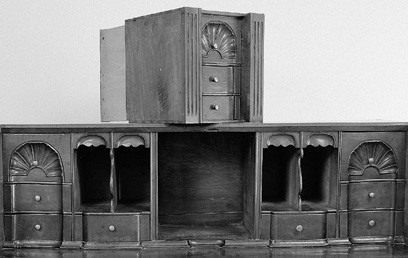
Detail of the prospect cabinet of the desk illustrated in fig. 33.

Detail of the prospect cabinet removed from a desk (not illustrated) attributed to John Sanders.

Detail of a foot on the desk illustrated in fig. 33.
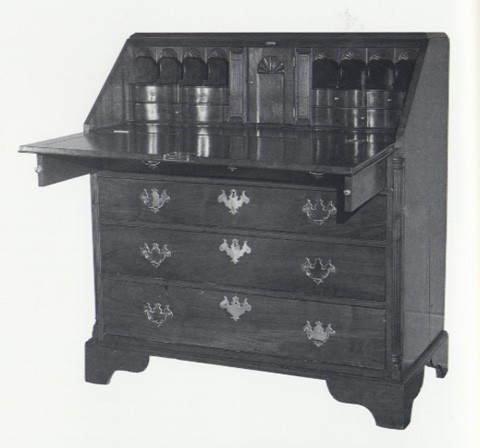
Desk attributed to John Sanders, Perquimans County, North Carolina, 1760–1776. Walnut with yellow pine, tulip poplar, and walnut. H. 42 1/2", W. 41 1/4", D. 21 7/8". (Private collection; photo, Museum of Early Southern Decorative Arts.)

Detail of the interior of the desk illustrated in fig. 38.
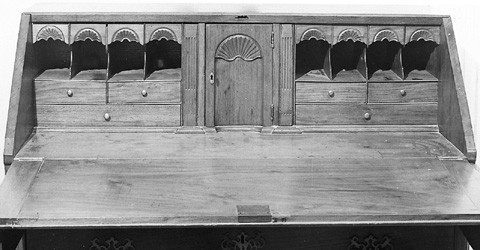
Detail of the interior of a desk (not illustrated) attributed to John Sanders, Perquimans County, North Carolina, 1760–1776. (Private collection; photo, Museum of Early Southern Decorative Arts.) The bases and capitals of the stop-fluted pilaster drawers are missing.

Detail of the prospect of a desk (not illustrated) attributed to John Sanders, Perquimans County, North Carolina, 1760–1776. (Private collection; photo, Museum of Early Southern Decorative Arts.) The feet of this desk are missing.

Detail of a quarter-column of the desk partially illustrated in fig. 40.

Tall clock case, Perquimans County, North Carolina, 1770–1790. Mahogany with white cedar and yellow pine. Dimensions not recorded. (Private collection; photo, Gavin Ashworth.) This clock descended in the Moore family of Perquimans County, North Carolina.
